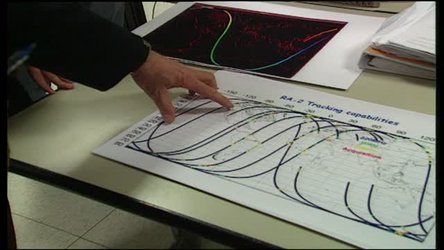
Envisat and Disaster Monitoring
ENVISAT & DISASTER MONITORING When major natural or man-made disasters occur the priority is to obtain fast and accurate information about what is going on. Satellites can provide that through the International Space and Major Disasters Charter. Find out all about the charter in this week's edition of Space. TC in : 10.00.40 When fire, poisonous fumes and molten rock come pouring out of the ground, it's spectacular .. but also often deadly. It's the same when summer wild fires rage through parts of Europe .. or elsewhere. To combat these catastrophies .. information is essential. Knowledge is power .. discovering the size of a disaster means the best way can be found to fight it. That's where the International Space and Major Disasters Charter comes in. With a catastrophe threatening .. as for example with the wild fires in Portugal .. the local civil authorities send a fax .. calling for help under the Charter. The fax arrives in Frascati near Rome .. where the European Space agency has centralised its operations for observations from space. First there's a check to make sure the fax has come from someone who is authorised to ask for their help. The Charter has been invoked more than seventy times since October 2000, when it was first organised by ESA and the space agencies of France and Canada. It now includes the US, India, Argentina and Japan and the UN is an important cooperating body. Once the operating checks have been completed .... The fax is passed on to the "emergency on call officer." On this occasion it's Simone Paolini. He immediately checks which satellites would be able to track the progress of the fires in Portugal. ITV "In this particular situation, I'll look to see the availablity of the Canadian Space Agency's RADAR-Sat. Then I would make a search for the availability of Envisat and make a request by fax to Spot Images to find out the availabilty of their satellite SPOT which is an optical satellite." The SPOT orbitor can see the ground only in the right weather conditions .. but radar satellites like ERS 2, have special sensors, which mean they can operate all the time. Reacting swiftly to requests for help is important .. according to Francesco Sarti, who heads the Charter project for the ESA: ITV "With the satellites, the time we have to requisition them is very limited. There are just a few hours after the original request, a maximum of twelve hours, the satellite's path, for example one of those which makes up the SPOT group, enables the first information to be acquired." The most advanced satellite .. ENVISAT .. has ten separate, different onboard sensors .. which makes it one of the most effective for the European Space Agency, in the kind of work carried out under the International Space and Major Disasters Charter. The information that's received is processed to make it most helpful .. to whoever orginally asked for assistance under the Charter. Oil pollution from shipwrecked oil tankers is one area where it is particularly effective. Thanks to satellite images tracking the spillages in real time, anti-pollution measures can be put in place quickly. The system works well with other types of natural disasters as well and the new generations of satellites provide data regardless of such factors as clouds and smoke. That means .. they can quicky give precise information on the state of roads and buildings after an earthquake .. even in the most isolated locations. Which is essential in order to know the best ways to send in help. At the satellite monitoring offices in Frascati ... activation of the Charter also gives access to extensive archives. That enables them to make exact comparisons with the previous images from the satellites. The archives .. which go back to 1991 contain all the information that the observation satellites of the ESA have gathered. They are kept to allow comparisons of places before and after a disaster. Overall, the system works well .. but it could be better: ITV Francesco Sarti "It would be nice to get the various civil authorities to improve their procedures and training in order that the satellite information that is transmitted .. can be used in the fastest and most efficient way possible. And for our part it would be great if we could boost the numbers of satellites and have satellites which would be just used for this type of work." Man's fragility in the face of forces of nature is undeniable, but at least this way .. we are making progress with being able to reduce the effects of major catastrophes. TC out : 10.06.00














 Germany
Germany
 Austria
Austria
 Belgium
Belgium
 Denmark
Denmark
 Spain
Spain
 Estonia
Estonia
 Finland
Finland
 France
France
 Greece
Greece
 Hungary
Hungary
 Ireland
Ireland
 Italy
Italy
 Luxembourg
Luxembourg
 Norway
Norway
 The Netherlands
The Netherlands
 Poland
Poland
 Portugal
Portugal
 Czechia
Czechia
 Romania
Romania
 United Kingdom
United Kingdom
 Slovenia
Slovenia
 Sweden
Sweden
 Switzerland
Switzerland






























